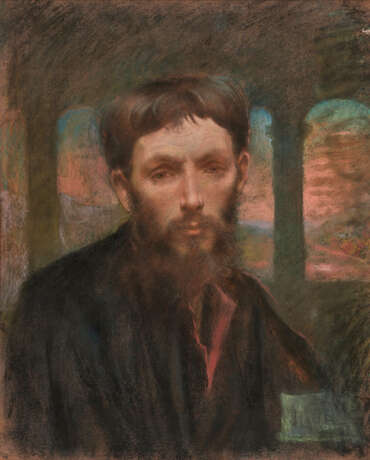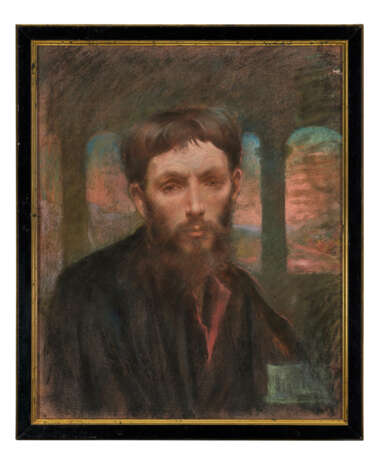ID 1172996
Lot 127 | LUCIEN LÉVY-DHURMER (ALGER 1865-1953 LE VÉSINET)
Estimate value
€ 40 000 – 60 000
Portrait présumé de Charles-Marie Dulac (1866-1898)
traces d’initiales (en bas à droite)
pastel sur papier orangé
63 x 52 cm (24 ¾ 20 ½ in.)
Provenance
Jacques Thuillier (1928-2011), Paris; sa vente, Artcurial, Hôtel Drouot, Paris, 1er février 2012, lot 306 (comme ‘école symboliste vers 1890’).
Collection particulière, Lyon.
Literature
J.-D. Jumeau-Lafond, ‘Un portrait de Charles-Marie Dulac ? Proposition pour un pastel inédit de Lucien Lévy-Dhurmer’, in La Tribune de l’art, 25 avril 2016 (consulté en ligne en février 2024).
Further details
LUCIEN LÉVY-DHURMER, PRESMED PORTRAIT OF CHARLES-MARIE DULAC, PASTEL ON ORANGE PAPER, SIGNED WITH INITIALS
This early pastel is an important rediscovery in the work of Lucien Lévy-Dhurmer. The artist’s highly distinctive treatment of pastel, his preferred medium, particularly between 1895 and the turn of the century, is eminently recognizable: tight execution and impressive modelling, coupled with a highly singular use of colour.
In 1896, his first monographic exhibition was held at the Galerie Georges Petit in Paris, where he appeared for the first time under the name Lévy-Dhurmer, adding to his surname Lévy part of that of his mother, Pauline-Amélie Goldhurmer.
A few other portraits, which combine veracity and attention to facial detail with symbolic significance, can be mentioned here as comparisons: the famous Portrait of Georges Rodenbach in Bruges and Pierre Loti and the Bosphorus, both in the Musée d’Orsay, Paris (inv. FR 36677, FR 12943; see J.-D. Jumeau-Lafond in Le Mystère et l'éclat. Pastels du Musée d'Orsay, exh. cat., Paris, Musée d’Orsay, 2008, pp. 157, 158, ill.). Unlike allegorical portraits such as La Bourrasque, formerly in the collection of Isabel Goldsmith (sale Christie’s, London, 30 June-14 July 2022, lot 8), Lévy-Dhurmer here depicts the portrait of a soul. Is this an allegorical work or a real figurative portrait? The cloister in the background reinforces the almost spiritual dimension of the work, of which the sitter must be sought in the artist’s close circle. Jumeau-Lafond suggests that it is a portrait of Charles-Marie Dulac, the mystic painter, lithographer and traveller who died prematurely at the age of 32 (Jumeau-Lafond, op. cit., 2016). Could it be a posthumous portrait, which would explain the melancholy that emanates from it?
Very few portraits of the young artist are known, including two photographs taken at different ages: full-length in front of the Basilica of St. Francis of Assisi, published in 1907 in the Revue alsacienne illustrée (fig. 1; IX, 1907, p. 81), and a second one, in which the artist appears younger with a rounder face, illustrated the catalogue of Charles Dulac’s posthumous exhibition at the Galerie Georges Petit in 1899 (fig. 2; E. Moreau- Nélaton, Marie-Charles Dulac, 1865-1898). Both the religious atmosphere of the work and the artist’s bearded, almost emaciated face are consistent. Finally, the presence of the cartel in the lower right-hand corner of the composition, partially erased, reveals a few letters, possibly referring to the sitter’s name (a D and an A can be made out).
| Applied technique: | Painted, Pastel |
|---|---|
| Medium: | Acrylic glass, Paper, Plastic |
| Genre: | Portrait |
| Place of origin: | Western Europe, France, Europe |
| Auction house category: | All other types of objects, Paintings, Watercolors, Drawings, Drawings, Watercolors and drawings |
| Applied technique: | Painted, Pastel |
|---|---|
| Medium: | Acrylic glass, Paper, Plastic |
| Genre: | Portrait |
| Place of origin: | Western Europe, France, Europe |
| Auction house category: | All other types of objects, Paintings, Watercolors, Drawings, Drawings, Watercolors and drawings |
| Address of auction |
CHRISTIE'S 9 Avenue Matignon 75008 Paris France | ||||||||||||||
|---|---|---|---|---|---|---|---|---|---|---|---|---|---|---|---|
| Preview |
| ||||||||||||||
| Phone | +33 (0)1 40 76 85 85 | ||||||||||||||
| Fax | +33 (0)1 40 76 85 86 | ||||||||||||||
| Conditions of purchase | Conditions of purchase | ||||||||||||||
| Shipping |
Postal service Courier service pickup by yourself | ||||||||||||||
| Payment methods |
Wire Transfer | ||||||||||||||
| Business hours | Business hours
|




